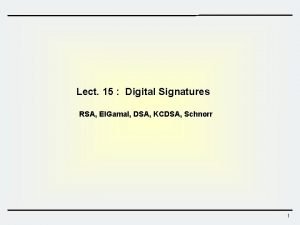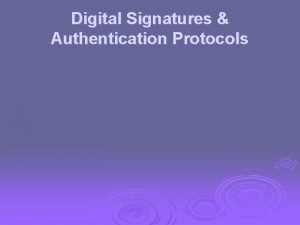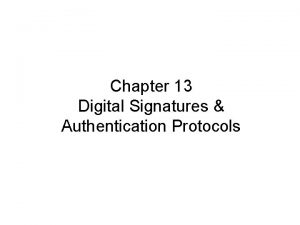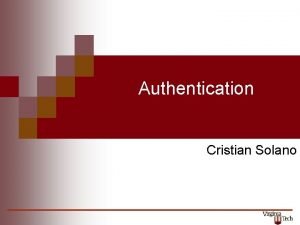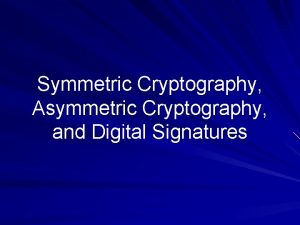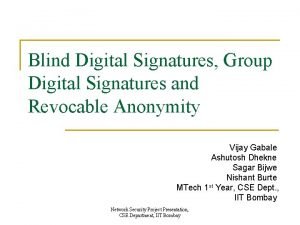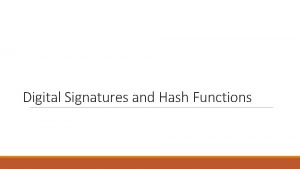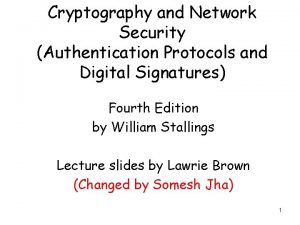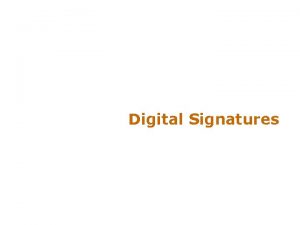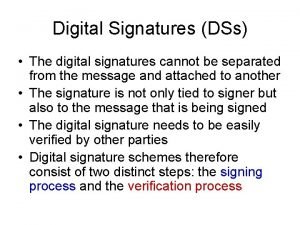Cryptography and Network Security Digital Signatures and Authentication













- Slides: 13

Cryptography and Network Security Digital Signatures and Authentication Protocols

Chapter 13 –Digital Signatures & Authentication Protocols To guard against the baneful influence exerted by strangers is therefore an elementary dictate of savage prudence. Hence before strangers are allowed to enter a district, or at least before they are permitted to mingle freely with the inhabitants, certain ceremonies are often performed by the natives of the country for the purpose of disarming the strangers of their magical powers, or of disinfecting, so to speak, the tainted atmosphere by which they are supposed to be surrounded. —The Golden Bough, Sir James George Frazer

Digital Signatures • have looked at message authentication – but does not address issues of lack of trust • digital signatures provide the ability to: – verify author, date & time of signature – authenticate message contents – be verified by third parties to resolve disputes • hence include authentication function with additional capabilities

Digital Signature Properties • must depend on the message signed • must use information unique to sender – to prevent both forgery and denial • must be relatively easy to produce • must be relatively easy to recognize & verify • be computationally infeasible to forge – with new message for existing digital signature – with fraudulent digital signature for given message • be practical save digital signature in storage

Direct Digital Signatures • involve only sender & receiver • assumed receiver has sender’s public-key • digital signature made by sender signing entire message or hash with private-key • can encrypt using receivers public-key • important that sign first then encrypt message & signature • security depends on sender’s private-key

Arbitrated Digital Signatures • involves use of arbiter A – validates any signed message – then dated and sent to recipient • requires suitable level of trust in arbiter • can be implemented with either private or public-key algorithms • arbiter may or may not see message

Digital Signature Standard (DSS) • • • US Govt approved signature scheme FIPS 186 uses the SHA hash algorithm designed by NIST & NSA in early 90's DSS is the standard, DSA is the algorithm a variant on El. Gamal and Schnorr schemes creates a 320 bit signature, but with 512 -1024 bit security • security depends on difficulty of computing discrete logarithms

DSA Key Generation • have shared global public key values (p, q, g): – a large prime p = 2 L • where L= 512 to 1024 bits and is a multiple of 64 – choose q, a 160 bit prime factor of p-1 – choose g = h(p-1)/q • where h<p-1, h(p-1)/q (mod p) > 1 • users choose private & compute public key: – choose x<q – compute y = gx (mod p)

DSA Signature Creation • to sign a message M the sender: – generates a random signature key k, k<q – nb. k must be random, be destroyed after use, and never be reused • then computes signature pair: r = (gk(mod p))(mod q) s = (k-1. SHA(M)+ x. r)(mod q) • sends signature (r, s) with message M

DSA Signature Verification • having received M & signature (r, s) • to verify a signature, recipient computes: w = u 1= u 2= v = s-1(mod q) (SHA(M). w)(mod q) (r. w)(mod q) (gu 1. yu 2(mod p)) (mod q) • if v=r then signature is verified • see book web site for details of proof why



Summary • have considered: – digital signatures – authentication protocols (mutual & one-way) – digital signature standard
 Authentication in cryptography and network security
Authentication in cryptography and network security Wireless security in cryptography
Wireless security in cryptography Dsa in network security
Dsa in network security Elgamal digital signature algorithm
Elgamal digital signature algorithm Cryptography and network security 6th edition
Cryptography and network security 6th edition Introduction to network security and cryptography
Introduction to network security and cryptography Number theory in cyber security
Number theory in cyber security Firewall base layer
Firewall base layer Intruders in network security
Intruders in network security Primitive root
Primitive root Cryptography and network security 6th edition pdf
Cryptography and network security 6th edition pdf Pearson cryptography and network security
Pearson cryptography and network security Source
Source Cryptography and network security 4th edition
Cryptography and network security 4th edition



